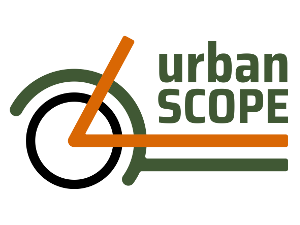Pilot testing the UrbanSCOPE Learning Methodology and tools
One of the core aims of UrbanSCOPE project was to develop a flexible, adaptable and innovative course for different target groups, namely university students, secondary school students and adults, in order to educate them on sustainable urban mobility. After the creation of the Learning Methodology, the following step of the project was to develop a generic course, and adapt (as well as test) it in the local context.
We have created an interdisciplinary course for university students addressing students of urban planning and design, but also students of transport departments, urban and regional development and public policy. This course of study, which can be used as an interdisciplinary ”module”, outlines the process for preparing a SUMP involving citizens in the process, and inviting local authority cooperation.
We have created a learning course for secondary school students and adults, as a “family education” course, allowing local communities in the participating cities to engage in local initiatives promoting SUMP. This course exploits many elements of the university course, but has been simplified and adapted to the learning modes of secondary education, including many practical examples and out-of-class fieldwork, to raise the interest of younger students primarily, and their families as a consequence, who do not probably have education experience in such fields as transport or town planning.
TUDA developed the eventual course that was tested with university students in Darmstadt, while SIU prepared the course that was tested with university students in Gyor. PRISMA adapted the generic course to meet the needs of secondary school students and adults, and tested the course in a secondary school in Glyfada, recruited with the help of the partner City of Glyfada, which manages all secondary schools in the city.
An innovative element of these courses was that the students could relate to real-world problems, by analysing their localities in depth, and providing solutions for achieving a more sustainable urban mobility on their area. This was supplemented by the use of digital and AR tools throughout the process, in order to geo-locate problems and necessary development. Although the UrbanSCOPE Digital Tool on the MEES platform was not ready for testing at this stage, the courses adapted and included suitable and available ICT and AR tools. For example, in the case of Darmstadt and Gyor, university students used Siftr (an AR tool) to gather information of the case study area, and later on used ARC GIS (a geographic information system program) to analyse and propose scenarios based on the results of the analysis. In the case of Glyfada, school students were asked to use Siftr systematically, in order to create a thorough analysis of the area and propose SUM solutions.
The expected impact of the proposed courses was similar to those outlined in IO3, in relation to the proposed methodology and learning tools: university students benefit from an interdisciplinary approach to urban planning and design, and their education interacted with the needs and experiences of city communities. On the other hand, schools and the adult public benefit from learning about SUMP in a playful and hands-on way, enjoying also an opportunity to increase their knowledge and awareness about the options for public participation in planning decisions, and the corresponding citizen’s rights to voice their opinions and become involved in an open debate.
You can learn more about the experiences of the pilot testing, by clicking on the following country-reports!
